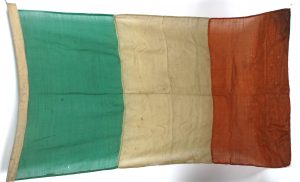History of the Irish Flag
The Irish tricolour is essentially a flag of union. Its origin is to be sought in the history of the early nineteenth century and it is emblematic of the fusion of the older elements, represented by the green, with the newer elements, represented by the orange.
The combination of both colours in the tricolour, with the white between in token of brotherhood, symbolises the union of the different stocks in a common nationality. Irish tricolours were mentioned in 1830 and 1844, but widespread recognition was not accorded the flag until 1848. 
From March of that year Irish tricolours appeared side by side with French ones at meetings held all over the country to celebrate the revolution that had just then taken place in France.
In April, Thomas Francis Meagher, aka Meagher of the Sword, the Young Ireland leader, brought a silk tricolour of orange, white and green from Paris and presented it to a Dublin meeting. John Mitchel, referring to it, said: “I hope to see that flag one day waving as our national banner.” At that time, however, and for long afterwards, the national flag was the green one with a yellow or gold harp.
Although the tricolour was not forgotten as a symbol of union and a banner associated with the Young Irelanders, it was little used between 1848 and 1916. Even up to the eve of the Rising in 1916, the green flag with the gold harp held undisputed sway. Neither the colours nor the arrangement of the early tricolours was standardised. All of the 1848 tricolours showed green, white and orange, but orange was sometimes put next to the staff, and in at least one flag the order was orange, green and white.
In 1850 a flag of green for the Catholics, orange for the Protestants of the Establishment and blue for the Presbyterians was proposed. In 1883 a Parnellite tricolour of yellow, white and green, arranged horizontally, is recorded. Down to recent times yellow had occasionally been used instead of orange, but by this substitution the fundamental symbolism is destroyed.
Associated with the secession movement in the past, flown over the GPO during the Rising and capturing the banner of the new revolutionary Ireland, it was soon acclaimed throughout the country as the national flag. It continued to be recognised by official usage during the period 1922-1937, when its position as the national flag was formally confirmed by the Constitution of 1937, Article 7 of which states: “The national flag is the tricolour of green, white and orange.”
